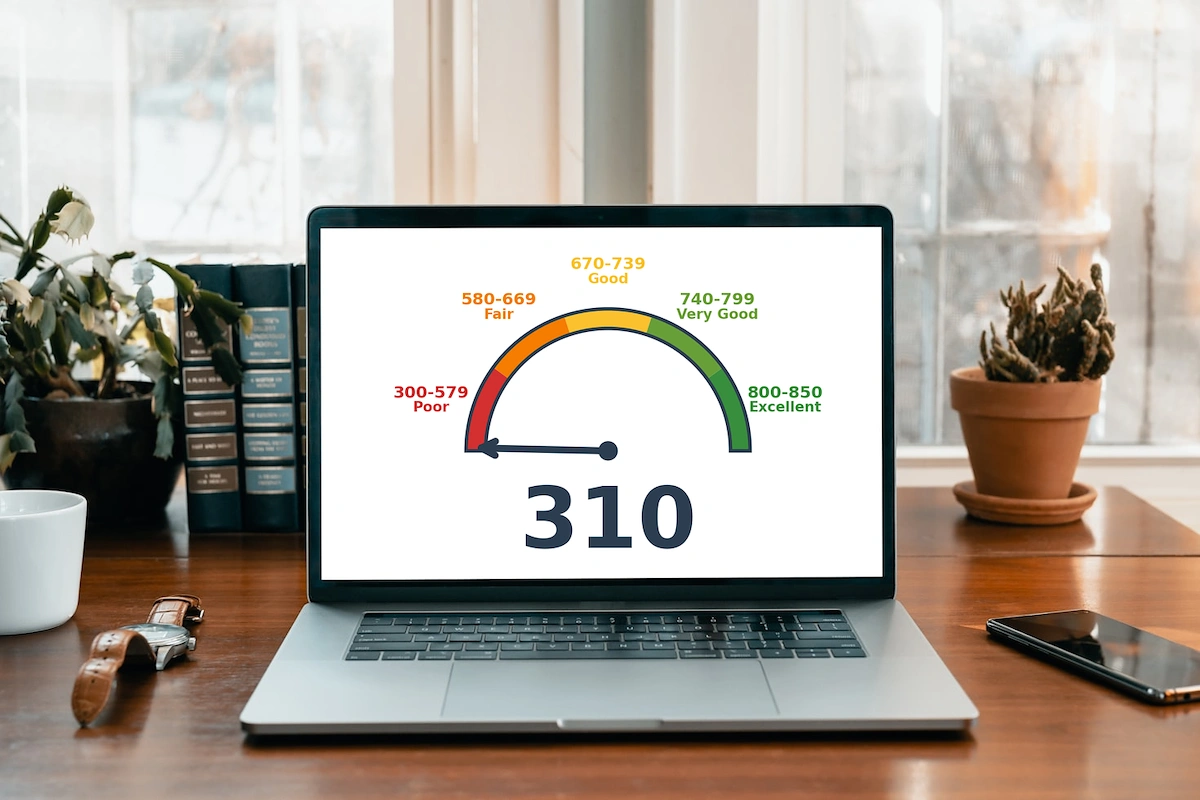
Kudos has partnered with CardRatings and Red Ventures for our coverage of credit card products. Kudos, CardRatings, and Red Ventures may receive a commission from card issuers. Kudos may receive commission from card issuers. Some of the card offers that appear on Kudos are from advertisers and may impact how and where card products appear on the site. Kudos tries to include as many card companies and offers as we are aware of, including offers from issuers that don't pay us, but we may not cover all card companies or all available card offers. You don't have to use our links, but we're grateful when you do!
310 Credit score: What You Need to Know in 2025
July 1, 2025


TL;DR
While a 310 credit score presents significant room for improvement, it provides a clear starting point for building a stronger financial foundation. This score falls into the "Poor" FICO score category, which is the first step on the path toward establishing a healthier credit history.
What Does a 310 Credit Score Mean?
A credit score of 310 falls into the "poor" category on the FICO Score range of 300 to 850. This number indicates to lenders a history of significant financial missteps, positioning you as a high-risk borrower. Consequently, this score can create substantial barriers in your financial life, making it extremely difficult to qualify for new credit cards, auto loans, or mortgages.
Facing the financial world with a 310 credit score means most applications for credit will likely be denied. In the rare case of an approval, you can expect to be offered very high interest rates and unfavorable terms. While this reality can feel restrictive, it's important to view it as a starting point. Recognizing where you stand is the first step on the path toward rebuilding your credit and improving your financial outlook.
Who Has a 310 Credit Score?
While age itself isn't a direct factor in calculating your credit score, there is a clear correlation between age and average scores. Data from 2023 shows a steady increase in credit scores with each successive generation. Here is the breakdown by generation:
- Generation Z (ages 18-26): 680
- Millennials (ages 27-42): 690
- Generation X (ages 43-58): 709
- Baby Boomers (ages 59-77): 745
- Silent Generation (ages 78+): 760
Credit Cards With a 310 Credit Score
A credit score of 310 falls into the “poor” credit range, which can significantly hinder your ability to get approved for a traditional credit card. Most lenders view such a low score as a major red flag, indicating a high risk of default on payments. Consequently, your options will likely be restricted to secured credit cards or specific subprime cards designed for individuals with very poor credit history.
Kudos offers personalized tools like the Explore Tool, which uses a quiz to understand your financial goals and provides curated recommendations based on your preferences. These resources help you compare various options, including cards designed to build credit, and offer insights into how each choice could affect your financial situation.
Auto Loans and a 310 Credit Score
A 310 credit score places you in the deep subprime category, which can make securing an auto loan challenging. According to a 2025 guide on auto loans, while approval is still possible, you will likely face significantly higher interest rates and less favorable loan terms.
- Super-prime (781-850): 5.25% for new cars and 7.13% for used cars
- Prime (661-780): 6.87% for new cars and 9.36% for used cars
- Non-prime (601-660): 9.83% for new cars and 13.92% for used cars
- Subprime (501-600): 13.18% for new cars and 18.86% for used cars
- Deep subprime (300-500): 15.77% for new cars and 21.55% for used cars
Mortgages at a 310 Credit Score
With a 310 credit score, qualifying for a traditional mortgage is virtually impossible. According to current mortgage requirements, mainstream loans have much higher minimums. FHA loans require a score of at least 500 with a 10% down payment, while conventional loans typically start at 620. A 310 score falls far below these thresholds, making approval from traditional lenders highly unlikely.
Even if you found a specialty lender, the impact on your loan would be severe. A score this low signals high risk, leading to extremely high interest rates and fees. You would also face stricter requirements, such as a larger down payment and a difficult manual underwriting process that heavily scrutinizes your finances, limiting your options and borrowing power.
What's in a Credit Score?
Understanding your credit score can feel like trying to solve a complex puzzle, as it's a blend of several key financial habits. The most common factors that determine your score include:
- Your payment history tracks whether you have paid past credit accounts on time.
- Credit utilization is the percentage of your available credit that you are currently using.
- The length of your credit history considers the age of your oldest account and the average age of all your accounts.
- Credit mix refers to the variety of credit products you have, such as credit cards, retail accounts, and loans.
- New credit inquiries and recently opened accounts can also temporarily impact your score.
How to Improve Your 310 Credit Score
Your credit score plays a crucial role in your financial life, and it is possible to improve your score with consistent, positive behavior. With a few proven methods, you can begin to build a healthier credit profile and see meaningful changes over time.
- Monitor your credit reports regularly. This helps you identify and dispute inaccuracies that could be unfairly lowering your score, while also allowing you to track your progress.
- Establish automatic bill payments. Since payment history is the most significant factor in your score, automating payments is the best way to build a consistent record of on-time payments.
- Apply for a secured credit card. For those with damaged credit, a secured card allows you to build a positive payment history as your activity is reported to the major credit bureaus.
- Become an authorized user. Being added to a responsible person's credit card allows their positive payment history and low credit utilization to appear on your report, which can help boost your score.
To help manage your cards and monitor your score as you improve it, consider using a financial companion tool like Kudos.

Supercharge Your Credit Cards
Experience smarter spending with Kudos and unlock more from your credit cards. Earn $20.00 when you sign up for Kudos with "GET20" and make an eligible Kudos Boost purchase.
Editorial Disclosure: Opinions expressed here are those of Kudos alone, not those of any bank, credit card issuer, hotel, airline, or other entity. This content has not been reviewed, approved or otherwise endorsed by any of the entities included within the post.




























.webp)
.webp)
.webp)
.webp)
.webp)

.webp)
.webp)
%20(1).webp)
.webp)